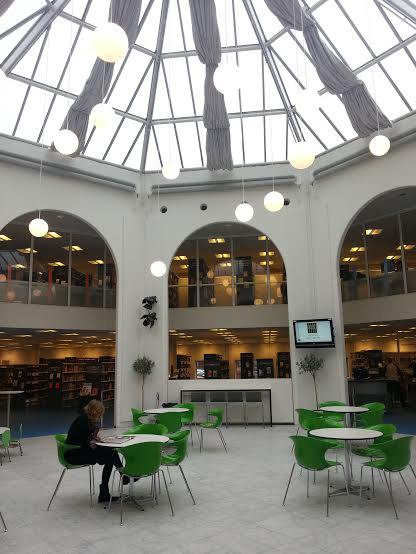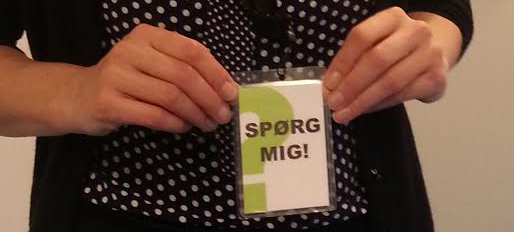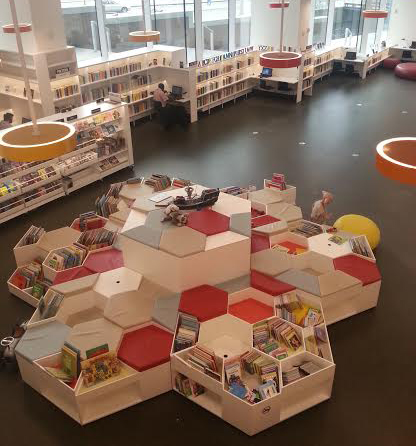Report from the Mid-Term Meeting of the IFLA Public Libraries Section in Malmö
What are the right ingredients for a good international librarians’ meeting? Start with some great speakers with inspiring messages, add visits to two or three gorgeous branches, then mix everything with nice colleagues, good food, and a lot of design shops. I tasted this recipe on February 27-28 during the Mid-Term Meeting of the IFLA Public Libraries Section, held in Malmö (Sweden) and in the Southern suburbs of Copenhagen (Denmark).
Drivers in City Development
Knud Schulz, manager of the Main Library in Aarhus, illustrated the new wave of iconic library buildings in three of the main Scandinavian cities, where a lot of money is invested and the best architects are competing. In Aarhus, the second-largest city of Denmark, “Dokk1” (17,500 m2) is defined as an “urban mediaspace” where the users enjoy a unique experience: “from information that can be found anywhere to what can only be experienced at the library” 1. In 2017-18 Helsinki (Finland) will have a new central library, called “Käännös” (“turn, translation”), a 16,000 m2 zero-energy wooden construction. The citizens are involved in the projects, through public debates etc., as in Oslo (Norway), where the new “Deichman” library, open in 2017 (13,900 m2), aims to play a leading role in Europe.
From a Place for Books to a Place for People
In the suburbs of Copenhagen (Denmark), Jens Nordentoft Lauridsen, Library Manager, explained how Tårnby Public Library moved “from a place for books to a place for people” after 2010. One of the library’s goals is to provide “events, learning sessions and happenings every day”2. Staff is encouraged to walk and talk instead of sit and wait, and also wear an “Ask me!” badge. An ongoing dialogue with the users is a key factor.
Learning centres are at the core of this shift. The Learning Centre at the Malmö City Library (Sweden) is a place for informal learning where well-equipped computers and various softwares (publishing, vector graphics editing, etc.) are available freely to everyone. “Potluck” and “sounding board” are two of the keywords of this space, because co-creation and the involvement of visitors are highly encouraged3. Small businesses are invited to transfer their offices temporarily there and contribute with workshops and lectures. Users from all over the world come to the Learning Centre to print, scan, edit pictures, use Skype, study English or Swedish languages, and edit audio and video.
In times of financial crisis, Danish and Finnish public libraries partner at a local level with municipalities so that citizens’ services are integrated in the library while at a national level consortia are made up for the acquisition of e-books and catalog data.
We Like to Try Something New
Marian Morgan-Bindon’s expression is paradigmatic of the new spirit of public libraries. She is the Manager of Library Services and Cultural Development at the City of Gold Coast (Australia), where augmented reality is only one of the latest experiences in the library4. Library spaces have become more and more flexible. Aarhus library organizes a “Transformation Lab” at the entrance of the Main Library, with new projects every 5-6 months, regarding literature, music, and democracy, but also using interactive floors and robots. Their philosophy is based on user-driven innovation and design thinking.
While some librarians are becoming coaches for patrons, others have made their libraries totally self-served facilities. As in a few other areas of the world (something similar already exists in Singapore), the Ørestad Library (in the Copenhagen area) provides unstaffed opening hours: Monday to Friday 8-10 a.m. and 6-10 p.m.; on Saturdays 8-11 a.m. and 4-10 p.m.; the whole day on Sundays (8 a.m. – 10 p.m.). In 2013 they recorded 60,000 visits in the unstaffed hours, with only a few reported accidents.
Resources
- Knud Schulz, Library Transformation: Sketching the future library transitioning to a space for citizens and community connections, slides presented at the Mid-Term Meeting of the IFLA Public Libraries Section, February 27, 2014;
- Jens Nordentoft Lauridsen, Welcome to all of you, slides presented at the Mid-Term Meeting of the IFLA Public Libraries Section, February 28, 2014;
- Stefan Wahlstedt, Investment in learning. The learning center in Malmö City Library, slides presented at the Mid-Term Meeting of the IFLA Public Libraries Section, February 27, 2014, provided by the author;
- Marian Morgan-Bindon, How the Digital Media lab delivers on the city’s Culture Strategy, slides presented at the Mid-Term Meeting of the IFLA Public Libraries Section, February 27, 2014; she is the Chair of the Section’s Standing Committee
**All photos courtesy of the author.










